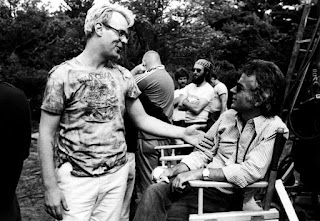SPOILER ALERT-SPOILER-ALERT-SPOILER-ALERT-SPOILER-ALERT-SPOILER-ALE
High Noon was
a fifties Western in which the marshal (Gary Cooper) had to face a
gang of killers alone. They are arriving by train, at noon and the
townsfolk refuse to help him. In the end, he confronts them alone,
with just the help of his wife, a pacifist. 1982's Outland is
set on Io, a moon of Jupiter. Sean Connery is the marshal of a mining
outpost and a group of hired killers are approaching on the resupply
shuttle. His deputies are corrupt or useless, the only aid from a
jaded
female Doctor. High Noon in
space. That's the comparison that always gets made from reviewers and
I wanted this out of the way as soon as possible.
Marshal William T.
O'Niel (Connery) is sent to Con-Am mine 27 on Io. Despite the hostile
environment, production is breaking records and the Manager Sheppard
(Peter Boyle) warns O'Niel that his people like to play hard. His
deputies are led by Montone, a Sergeant (James B.Sikking of Hill
Street Blues fame).
Carol O'Niel (Kika Markham) has had enough of these places and
takes their son Paul and heads back to a waystation for the long
journey back to Earth.
One of the miners
goes crazy, ripping open his spacesuit and another goes down an
elevator/airlock without his
suit – another turns psychotic and takes a hooker hostage. Before
O'Niel can make the arrest, Montone blasts him with a riot gun.
Determined to investigate these deaths, the Marshal twists the arm of
Company Doctor Lazarus (Frances Sternhagen) and a drugs
ring is uncovered – a synthetic stimulant
called polydichloric euthimal. This stuff makes you work like a
horse... and eventually sends you psychotic. O'Niel goes after the
dealers and finds the conspiracy of silence goes right up to
Sheppard.
After
the marshal destroys the new shipment, Sheppard then calls his
supplier requesting a hit on O'Neil. Cannily, the Marshal is
monitoring the transmission and seeks help, but he's on his own –
save for Doctor Lazarus. The resupply shuttle arrives, with it two
hitmen (Including P.H. Moriarty, 'Hatchet Harry' from Lock,
Stock & Two Smoking Barrels).
Going 'Outside', O'Niel tricks
one of the killers into a corridor, placing an explosive charge
outside and killing him with decompression. The second hitman is
prowling around inside a hydroponic greenhouse when he sees a
movement – and fires, blasting a hole through the outer
skin and out he goes.
So
far, O'Neil is ahead, but a shot comes from nowhere. It's Ballard, a
deputy, and he's crossed the fence. O'Neil climbs up a massive solar
array, across a catwalk to a point above the prowling figure of the
rogue deputy. It's a matter of time before he's spotted and killed,
so he leaps into the low gravity void... landing on Ballard and
knocking his gun down the vast slope. Desperately, the two struggle
until they go over the side of the walkway and fall gently down to
crash into another lower down. Ballard goes over the side, but is
strong – maybe artificially so. Desperately, the Marshal manages to
get hold of Ballard's air hose and yank it free, the body falling
free until it hits one of the capacitors and is fried. O'Neil
lays Sheppard out and leaves him to the inevitable reprisals from his
supplier. He thanks Doc Lazarus and sends a message to his Wife and
Son. He'll be joing them for the flight home.
Writer/Director
Peter Hyams (Capricorn One)
wanted to do a Western, the studio didn't. Placing High
Noon in space was inspired; all
the key elements work well and transplanting
stories across genres is more commonplace than you might realise.
The performances are all
there, too; Connery is
flinty, without being unsympathetic as the washed-up lawman, Boyle
makes an unlikable baddie and Sternhagen's Lazarus is well placed as
an over-the-hill quack with a heart.
I
have to make time here and mention Megasound
and Introvision. Megasound?;
Warner Brothers' system
involved speakers and amps behind the screen to provide booming bass
for sound effects. An offshoot of the seventies experimental sound
systems such as those being developed by Dolby, it was basically a
gimmick. It only made it onto a handful of releases due to the cost
to cinemas of installing the equipment needed. Introvision, however,
was more than just an enhancement. A front projection technique that
allowed camera-operators to match up the effects shots with the live
action in the camera. Before this, the two would be composited and
only seen after the film was back from the processors. For the extra
brightness needed, Scotchlite screens were used – you've seen
similar material on road signs and high-visibility clothing. (To see
just how bright retroreflective materials are, shine a pen-laser at a
road sign at night.) By
mounting the camera at a right-angle to the screen and using a
beam-splitter to convey the image to the lens, a perfect match was
achieved. If you're wondering why the actors, props etc weren't lit
up with parts of the background image, the answer is pleasantly
simple. The lighting on the actors (etc) had to be bright enough to
match them with the brilliant background – and that washed away
elements of background that would have otherwise ruined the effect.
Ingenious. Sadly, computers
made the system appear obsolete and it was last seen on The
Fugitive. Rather distastefully
Hyams took on Stephen Goldblatt as cinematographer for the
sole reason of needing a scapegoat if the relatively untested
Introvision system failed. Goldblatt held his tongue – he needed
the work – but never forgave Hyams.
ABOVE/BELOW: Jim Steranko's impressive comic adaptation was featured in Heavy Metal
Innovative and
familiar by turns, Outland has
been largely forgotten by all but the fans. Hopefully, you'll now
help redress this injustice and spread the word...




















